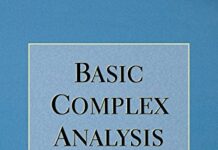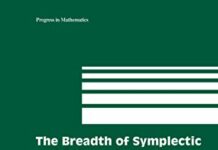
Ebook Info
- Published: 2012
- Number of pages: 578 pages
- Format: PDF
- File Size: 23.02 MB
- Authors: Jerrold E. Marsden
Description
This advanced-level study approaches mathematical foundations of three-dimensional elasticity using modern differential geometry and functional analysis. It is directed to mathematicians, engineers and physicists who wish to see this classical subject in a modern setting with examples of newer mathematical contributions. Prerequisites include a solid background in advanced calculus and the basics of geometry and functional analysis.The first two chapters cover the background geometry ― developed as needed ― and use this discussion to obtain the basic results on kinematics and dynamics of continuous media. Subsequent chapters deal with elastic materials, linearization, variational principles, the use of functional analysis in elasticity, and bifurcation theory. Carefully selected problems are interspersed throughout, while a large bibliography rounds out the text.
User’s Reviews
Reviews from Amazon users which were colected at the time this book was published on the website:
⭐Provides a great understanding of the mathematical aspects of continuum mechanics. A must-read for Mechanical engineering students who love mathematics.
⭐If you are an engineer and like to learn elasticity, it is not your book. This is more for people who are working in theoretical mechanical in engineering, theoretical physic or applied math. Even the people in these area should have very strong knowledge in some pure math like topology and manifolds .The books gives very solid and great view to theory behind elasticity.
⭐Uses a lot of bizarre notation that isn’t quite standard (a trend with Marsden, IMO), but has information in it that’s really difficult to find in engineering texts on elasticity. Fills a pretty obscure niche, but it was one that I needed filled.All the foundational definitions and discussion are really valuable.Most of the section on stability, though, is ranty: it speaks about stability in a pretty general way, and while it does spend time on elastic stability, there’s too much generic dynamical systems stuff with very few actual equations and a lot of word bloat.
⭐Difficult material, but elegant presentation — A classic
⭐Excelent. Provides the link between elasticity and mathematical ideas in a very nice way. Very good. Requires a good background.
⭐This book provides a mathematically rigorous introduction to the theory of elasticity. This book is excellent for pure/applied mathematicians with background in differential geometry and functional analysis interested in learning the basics of elasticity. Before I found this book I tried to learn some elasticity theory from many other books, however the biggest obstruction was always the lack of clarity in the mathematical formulation. Most of the books dealing with theory elasticity do not provide clear definitions of basic mathematical concepts they use throughout the book, as a consequence this produces a very informal exposition difficult to reconciliate with the usual concepts in differential geometry. Marsden & Hughes’ book fill this gap in the literature giving a rigorous mathematical exposition easily understandable by any math student with background in differential geometry.Courses in theory of elasticity are very common in the core curriculum of mathematics programs at Russian universities. There are dozens of excellent textbooks in Russian aimed at mathematics students, however as I mentioned before, in the English literature this is the first book, as far as I know, that provides such a mathematical presentation of the subject. I really recommend this book to any pure/applied math student looking for a good introduction to elasticity with the same language and mathematical rigour as we are used to.On the other hand, I would say that this book is not very suitable for engineering students (at the level of universities/colleges in North America), however they have plenty of books where they can learn elasticity from the applied or computational point of view.
⭐Though I’m a engineer in practice I bought this book out of personal interest to further my knowlegde. When I first opened the book I was a taken aback by the amount of mathematics used. Having a good knowledge of the classical theory of elasticity and some non-linear theory is simply not enough to begin with this book. Know your mathemactics! (differential geometry,etc.) Appart form the starting difficulies the book has very much to offer and is well written. I especially liked the “exotic” topics like relativistic elasticity and bifurcation theory of beams and plates. This book is very different compared to the books I used to read on elasticity but I still enjoy it.
⭐Sb. said this book turns 1+1=2 into a nightmare, however I can’t agree.First, this book is not written for engineers. For engineers, there are a dozen of good elasticity books, eg. the classics Fung’s “Foundation of solid mechanics”. This is not the right book for engineers.This book deals elasticity within the context of manifold. For these of you who really want to know what a tensor really is, what the real meaning of these 1+1=2, for example C=F’F, in the general settings, this is the right one.As it is said, knowing elasticity, finite deformation theory, nonelasticity is still not enough to open this book. All you need to know is a lot of differential geometry and tensor calculus. This book also try to build up these notions. Good concurrent books to help you understand are “tensor calculus on manifold” by Bishop et. al, and “the geometry of physics” by Frankel.Overall, this is a book very hard to penetrate, and only intended for the advanced level. You won’t expect to learn any elasticity from this book if you are new to elasticity. I recommend you to return back to this classic when you think you are ready, you will find a whole new world.
⭐This book provides a mathematically rigorous introduction to the theory of elasticity. This book is excellent for pure/applied mathematicians with background in differential geometry and functional analysis interested in learning the basics of elasticity. Before I found this book I tried to learn some elasticity theory from many other books, however the biggest obstruction was always the lack of clarity in the mathematical formulation. Most of the books dealing with theory elasticity do not provide clear definitions of basic mathematical concepts they use throughout the book, as a consequence this produces a very informal exposition difficult to reconciliate with the usual concepts in differential geometry. Marsden & Hughes’ book fill this gap in the literature giving a rigorous mathematical exposition easily understandable by any math student with background in differential geometry.Courses in theory of elasticity are very common in the core curriculum of mathematics programs at Russian universities. There are dozens of excellent textbooks in Russian aimed at mathematics students, however as I mentioned before, in the English literature this is the first book, as far as I know, that provides such a mathematical presentation of the subject. I really recommend this book to any pure/applied math student looking for a good introduction to elasticity with the same language and mathematical rigour as we are used to.On the other hand, I would say that this book is not very suitable for engineering students (at the level of universities/colleges in North America), however they have plenty of books where they can learn elasticity from the applied or computational point of view.
⭐Very clear mathematical exposition on elasticity. But not for faint heart. The mathematics highly rely on differential geometry and exterior calculus, a concise exposition of the related concepts is provided. It is a classic.
⭐This book is a classic on this topic, and a masterpiece on Mathematics of Elasticity. Highly recommended for engineers willing to learn advanced mechanics and mathematicians willing to learn something about mechanics.
⭐Das Buch stellt die mathematischen Grundlagen der Elastizitätstheorie dar. Sehr akribisch und detailreich geschrieben, kann das Buch für Spezialisten in der Elastizitätstheorie als moderne Referenz dienen.non dovrebbero servire molte parole; basterebbe leggere il nome dell’autore per rendersi conto della qualità del testo. Purtroppo le basi da cui parte questo testo sono molto avanzate e non è di facile lettura. Ma questo è insito nello studio di questo argomento.ottimo
⭐
Keywords
Free Download Mathematical Foundations of Elasticity (Dover Civil and Mechanical Engineering) in PDF format
Mathematical Foundations of Elasticity (Dover Civil and Mechanical Engineering) PDF Free Download
Download Mathematical Foundations of Elasticity (Dover Civil and Mechanical Engineering) 2012 PDF Free
Mathematical Foundations of Elasticity (Dover Civil and Mechanical Engineering) 2012 PDF Free Download
Download Mathematical Foundations of Elasticity (Dover Civil and Mechanical Engineering) PDF
Free Download Ebook Mathematical Foundations of Elasticity (Dover Civil and Mechanical Engineering)



